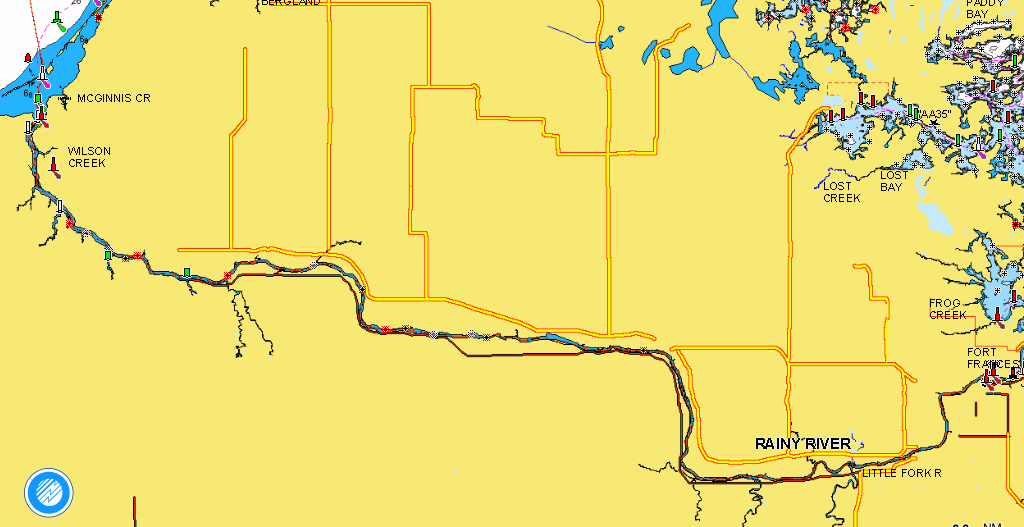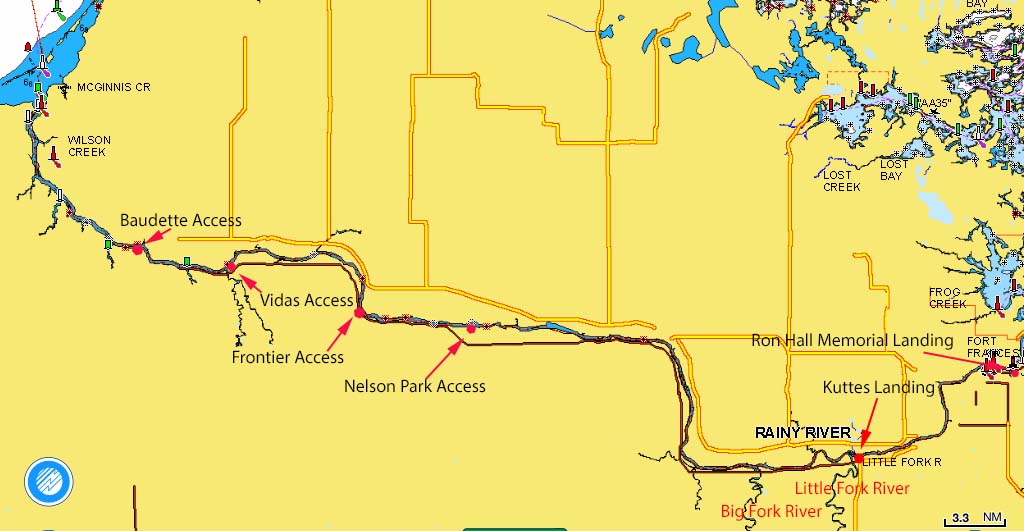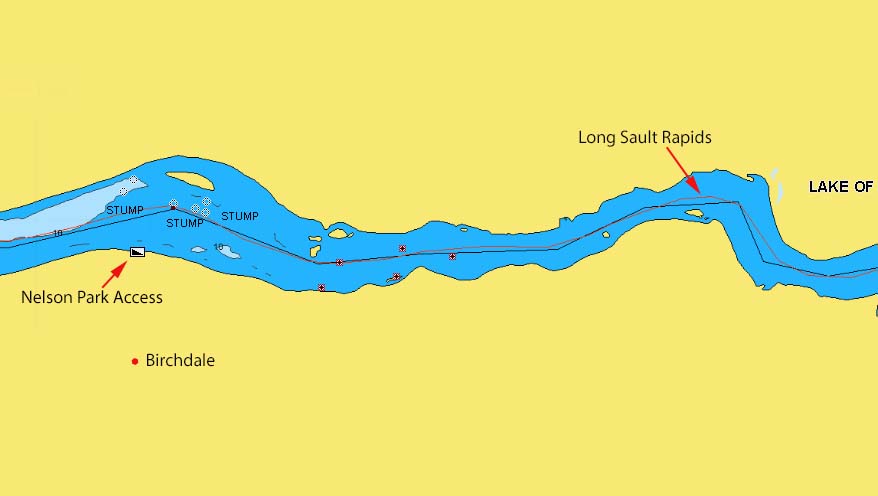
The 85-mile stretch of the Rainy River from International Falls, MN, to Lake of the Woods is certainly among the finest fishing destinations in all America. Each year, in early spring—thanks to the extended fishing season (March 1 to April 14 in 2017) on the river, anglers arrive in droves to participate in what’s typically one of the hottest walleye bites on the planet.
Resident walleyes, along with fish from downstream Lake of the Woods, flood the waterway in early spring, offering anglers a chance to catch not only numbers of fish, but a better-than-average shot of boating a true trophy-class walleye.
Northland Fishing Tackle co-founder Duane Peterson has years of experience fishing the Rainy and says that while the river should be on every walleye angler’s must-visit list, there are some things they should know before making the trek.
“The influx of walleyes is what draws anglers to the river,” he says, “and though there are several places to launch boats, they all get crowded; the wait to get your rig in the water can tend to tax your patience.
“You have to keep in mind that the reason they’re crowded is that the fishing is world-class. So, be patient; remember that everyone is there for the same reason—to have fun catching big walleyes—and it makes more sense to help each other out at the launch ramp instead of getting frustrated. The fish will be all along the river, so once you’re on the water, there will be plenty of room to spread out.”

Parking at many of the launch facilities is at a premium, as well. Depending on the day, and when they arrive, anglers should expect to have to park a certain distance from the ramp area. Two that offer the most parking, according to Peterson, are the Baudette Access in Timbermill Park just east of the city and the Vidas Access about 1½ miles east of the town of Clementson. “Nelson Park access at Birchdale, the Frontier access, and the Vidas access get the most attention because they usually open up first,” he says.
Remember, too, that the Rainy forms the boundary between Minnesota and Ontario. Anglers who plan to fish on the Canadian side of the river must have in their possession a valid Ontario fishing license, as well as an Outdoors Card and a Remote Area Border Crossing permit. “Many fishermen stick with a Minnesota fishing license, though, and simply stay on the American side of the river,” says Peterson. “Really, you can catch all the walleyes you want without crossing the mid-river borderline.”
Finally, to protect the fishery, tighter bag and slot limits are in place during the extended season. An angler may keep two walleyes per day, and all fish more than 19½ inches in length must be released.
Though walleyes are the river’s premier gamefish species, especially during the early season, recreational anglers target other fish as well. Rainy River offers a world-class lake sturgeon fishery, for example, and many anglers go there to target smallmouth bass and northern pike. Here’s Peterson’s take on how to make the most of your time on the Rainy River.
1. Because the extended season occurs so early in the calendar year, fishing is subject to the whims of nature and its weather. “It’s all a matter of timing,” says Peterson, “because water levels, snow cover, air temperature, wind, rainfall, and the amount of sunlight are all factors in when the ice breaks up and the river is open to general boat traffic. Sometimes it occurs earlier, but you can typically count on being able to fish by the last week of March.”
There are also times when one or more launch ramps will be open while others are still encased in ice. Fortunately, there are a number of access points anglers can use, and a call to a tackle shop or an online search of Rainy River fishing reports will direct anglers to available launch sites.
Walleye fishing is typically best as soon as the river opens because the water is clear, he explains, adding that once tributaries like the Big- and Littlefork rivers begin dumping silt and debris into the Rainy, the action drops off. “It’s always best to fish it as early as you can,” he says, “or catch the window that opens after the water has cleared following the flush of the Littlefork, Bigfork, and other tributaries.”
A variety of techniques will produce walleyes now, but the predominant method is to jig vertically while slipping the current with the boat. “Fish the edges of deeper holes, or right down the middle of the holes,” says the angler, “but the main thing is to keep the bait near the bottom. It might mean using a 3/8- or 5/8-ounce jig head, or if the current is docile, a 1/8- or ¼-ounce. You’ve got to take into account current speed and wind to determine the best jig weight and shape. It’s actually a situation where you need to experiment with different jig styles and weights to come up with the perfect combination.”
The angler recommends using a Fire-Ball® Jig or a Neon RZ Jig tipped with a shiner or rainbow chub as his old-school favorite presentation. But a Slurp!® Jig Head rigged with an Impulse® Paddle Minnow or Swim’n Grub are likewise productive.
“Both of these jig styles will work great,” says Peterson, “but so will a Whistler® or Thumper® jig, and sometimes the added noise and flash from the blade makes a big difference.” In all cases, he recommends going with bright colors or neon shades.
While jigging deep water is a reliable approach, anglers shouldn’t hesitate to cast into and jig shallow water, Peterson adds, as walleyes may be cruising and feeding on the flats. Likewise, trolling minnow-body crankbaits is yet another option, and allows anglers to cover water more quickly.
“Fishing can get more difficult when runoff turns the water murky,” says Peterson. “When that happens, a good approach is to anchor up at the head or along the edge of a hole and fish vertically without moving the jig too much. Here again, you need to determine a jig weight and style that will keep your bait near the bottom in the current.”
This is basically what sturgeon anglers do, but they’ll be fishing the bottom with a gob of nightcrawlers or dead minnows on a circle hook. Walleye anglers may even hook a lake sturgeon incidentally, but keep in mind that catch-and-release rules are in effect until April 23, so all fish must be returned to the water unharmed.
“If the water gets extremely muddy downstream, I’ll sometimes trailer my boat to Knuttes Landing at Pelland and fish upstream of the Little Fork River mouth; the water will usually be clearer there.”
Because walleyes will be spread throughout the river system, marking hotspots on a map is virtually pointless, according to the angler. “You can get on the water at any open landing and pretty much find a place where you can catch walleyes.”

As a starting spot, however, he suggests trying the waters below Long Sault Rapids upstream from the Nelson Park access north of Birchdale, MN. “A lot of fish will congregate below the rapids,” he says, “but you’ll also encounter a lot of other fishermen. If you get tired of fishing in a crowd, simply move downstream until you find a hole or outside river bend with deeper water.”
Another popular spot, he adds, is the river mouth downstream of Pinewood, Ontario. Anglers must be sure to stay on the American side unless, of course, they possess an Ontario fishing license as well as the appropriate permits previously mentioned.
2. After the extended season ends, walleye fishing commences again with the general season opener in mid-May. Most of the walleyes that entered the river will have migrated back to Lake of the Woods by then, however, according to Peterson. “Some fish won’t have made it that far, and some of them are resident fish that stay in the river all year long,” he says. “The population is fishable, and you can use the same techniques you did earlier in the year.”
As the season progresses, smallmouth anglers also begin to fish the river, particularly the upper end from Pelland to International Falls, where the bottom is rocky and more suited to bass.
“These fish are more structure-oriented than the early walleyes,” says the angler. “Look for them in current breaks and around rocks along the shoreline or sandbars related to creeks or culverts.”
The angler’s favorite smallmouth medicine is a ¼-ounce Slurp!® Jig with a 3.5-inch Impulse® Paddle Minnow or the new Core Swimbait. “Just cast and swim it back,” he says. “Cast and swim—cast and swim—everywhere you find rocks, a sandbar or a current break. It’s pretty much Smallmouth 101.”
Soft plastic tube baits rigged on a 1/8- to ¼-ounce Inner-Tube® Jig comes in a close second, he adds, and in the right situation throwing a topwater or a spinnerbait is the best way to go.
Quality northern pike and more than a few muskies are present in the upper river as well, Peterson adds. To catch these predators, try casting a Reed-Runner® Magnum Spinnerbait, “They’re absolutely lethal on these fish,’ he says.
During the fall, two things occur. First emerald shiners migrate up the river from Lake of the Woods, dragging hungry walleyes with them. Anglers typically use the previously outlined jigging and trolling techniques to catch them. Second, lake sturgeon go on a roll again, much to the delight of the bottom-fishing dinosaur hunters.
Lake maps courtesy of Navionics. For more information, visit: Navionics.com
Vital Stats
Rainy River
Length: 85 miles
Notable Catches: Walleye, 35.1 inches (released); Lake Sturgeon, 100-plus pounds (released)
Species Present: Walleyes, Sauger, Northern Pike, Muskies, Smallmouth Bass, Lake Sturgeon, Yellow Perch, Emerald Shiners and other forage species.

